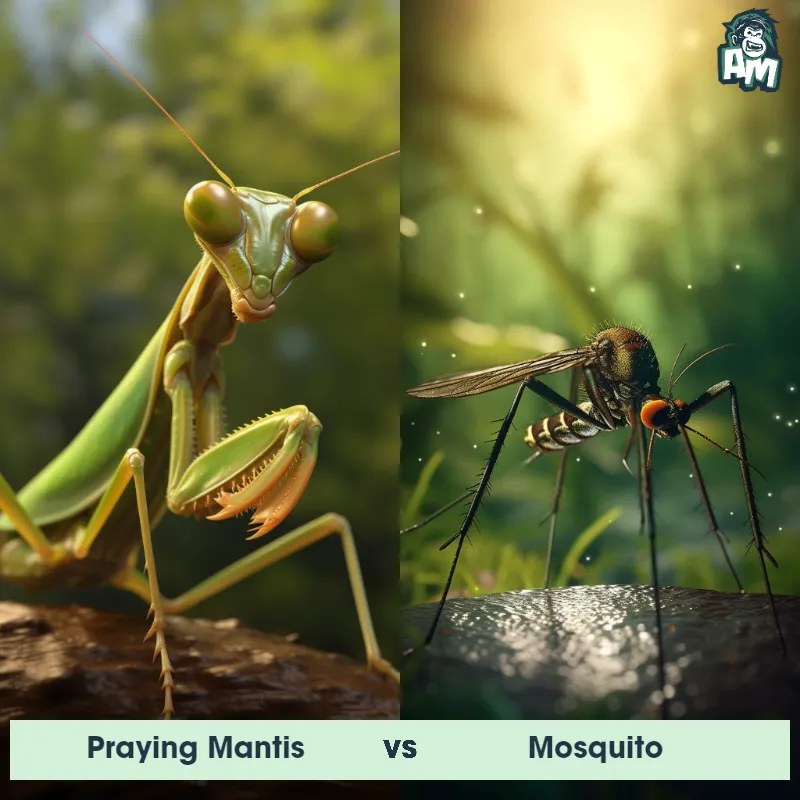Praying Mantis vs MosquitoSee Who Wins

Ladies and gentlemen, welcome to this highly anticipated matchup between two fierce competitors. In one corner, we have the agile and cunning Praying Mantis. And in the other corner, we have the quick, elusive, and irritating Mosquito. Get ready for an electrifying showdown as these two insects go head-to-head in an all-out battle of the insects!
Contender 1: Praying Mantis
The Praying Mantis is a fascinating insect known for its unique appearance and predatory behavior. With elongated bodies and large, triangular heads, these insects are easily recognizable. They have two large, compound eyes and three small simple eyes, which allow them to see in multiple directions at once. Their front legs are modified into powerful grasping appendages, which they use to catch and hold their prey. Praying Mantises are also known for their ability to camouflage themselves, blending in with their surroundings to avoid detection.
Fun Fact: Praying Mantises are known for their cannibalistic behavior, with females often eating their male partners after mating.
Contender 2: Mosquito
The Mosquito is a small, flying insect that is known for its itchy bites. They have long, thin legs and a slender body with two wings. Mosquitoes are found all over the world and are known to carry diseases such as malaria and Zika virus. They are attracted to humans and animals by the carbon dioxide we exhale and the scent of our sweat.
Fun Fact: Mosquitoes are attracted to people who have recently eaten bananas because they are attracted to the chemical compounds found in bananas.
Matchup Stats
| Praying Mantis | Mosquito | |
|---|---|---|
| Size | 2-5 inches (5-13 cm) | 0.125-0.75 inches (3-19 mm) |
| Weight | 0.1-0.6 ounces (3-18 grams) | 2.5 milligrams (0.000088 oz) |
| Speed | Speed: 1.5 mph (2.4 km/hr) | Speed: 1-1.5 mph (1.6-2.4 km/hr) |
| Key Strength | Powerful grasping front legs | None |
| Biggest Weakness | Vulnerable to being flipped onto their backs | Fragile wings |
Current Votes
Praying Mantis vs Mosquito
See Who Wins
View More Matches
Looking For More?
Similar Matches
Scientific Stats
| Praying Mantis | Mosquito | |
|---|---|---|
| Scientific Name | Mantodea | Culicidae |
| Family | Mantidae | Culicidae |
| Habitat | Terrestrial | Freshwater and wetland areas |
| Geography | Worldwide | Worldwide |
| Diet | Insects, spiders, and other small animals | Nectar and plant juices (males), blood (females) |
| Lifespan | 6 months - 1 year | 1 day - 2 weeks |
Key Differences between Praying Mantis and Mosquito
- Antennae: Praying Mantis Praying Mantises have long and slender antennae, often longer than the length of their body. Mosquito Mosquitoes have shorter and feathery antennae, which are typically shorter than their body length.
- Body Shape: Praying Mantis The Praying Mantis has a long and slender body with a distinct triangular-shaped head. Mosquito Mosquitoes have a slender and elongated body with a small oval-shaped head.
- Wings: Praying Mantis Praying Mantises have two pairs of wings, with the front pair being thick and leathery, resembling leaves when at rest. Mosquito Mosquitoes also possess two pairs of wings, but their wings are long, narrow, and covered with tiny scales.
- Appendages: Praying Mantis Praying Mantises possess raptorial forelegs, which are modified for grasping prey. These legs are large and prominently present. Mosquito Mosquitoes have six thin legs that are adapted for walking and clinging onto surfaces.
- Mouthparts: Praying Mantis Praying Mantises have strong and sharp mandibles, suited for capturing and devouring insects. Mosquito Mosquitoes have a long, needle-like proboscis that is adapted for piercing the skin of animals to suck blood.
- Size: Praying Mantis Praying Mantises are generally larger in size, ranging from 1 to 6 inches in length, depending on the species. Mosquito Mosquitoes are significantly smaller, usually measuring between 1/8 to 1/4 inch in length.


























